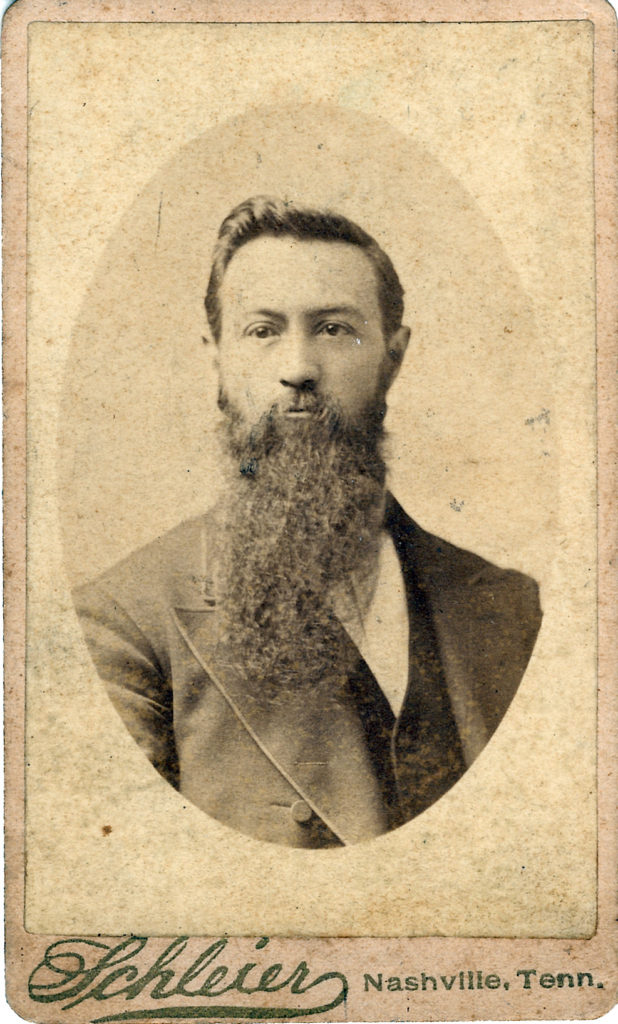
(1849-1937)
Moore county, Tennessee was established by an act of the General Assembly of the State of Tennessee in 1872. Most of its territory was out off Lincoln County, Tennessee. The members of the Parkes family, emigrating to Tennessee from North Carolina, settled in what was then Lincoln County, Tennessee. The section of country in what is now Moore county was first settled in the first decade of the nineteenth century. Among the first settlers in what is now Moore county were Woody B. Taylor and his wife, Nancy (Seay) Taylor, father of John H. Taylor, who settled there in about the year 1809; Mrs. Agnes Motlow, widow of John Motlow of South Carolina, a colonel in the patriot’s army in the Revolutionary War, who settled there about the year 1809 or 1810, with her sons, Zadoc, William, James, John and Felix, and a daughter, Elizabeth, who married Andrew Walker, and Lauriett, a daughter, who married a Massey; and Moses and Issac Crawford. Moses Crawford came to what is now Moore county, Tennessee, about the year 1809. While I was editor of the LYNCHBURG FALCON, I received a letter from Moses Crawford, who was then living at Grand Island, Nebraska. This letter was published in the Falcon of that date. In this letter Mr. Crawford said that he came to what is now Moore county and settled at or near Lynchburg in 1809. That he “Attended the sale of lots when the town was laid off in lots and sold”. He stated that the valleys, when he settled there, were covered with canebrakes. Mr. Crawford referred to the great northwestern corner of the State. This shock was sensibly felt in this section of Middle Tennessee and Mr. Crawford in his letter says: “the prevalent idea was that Judgement is knocking at the door. The earth reeled as a drunken man. Mercy was sought and pardon granted in many cases… There was preaching every four weeks at my father’s house. Rev. Adams of Flat Creek was minister or pastor in charge. My father and mother were old members of said church for years before. People came from far and near to hear the Scripture propounded. The ministers were Adams, Hardy, Holman, and Whitaker. The additions to the church were large every Sabbath. There were none but Baptists in this neck of the woods. They used to take the applicants for baptism down to the ford, singing as they went. The place for immersion was near where Rountree built his dam across Mulberry. Revivals stopped and drinking liquor began. I think I knew some of your ancestors. Two brothers by the name of Parks came there some time between 1815 and 1820, I think, with the Smiths. Time rolled on and rolled them off, and I, too, soon shall follow.”
The Parkes referred to by Mr. Crawford were Col. Thos. L. D. Parkes and Martin L. Parkes, 1st., both of whom married daughters of William Smith, a revolutionary soldier, who settled in this (now Moore County) section. William Smith when he died, was the owner of the farm now (1924) occupied by Lem Motlow, situated about one mile north or northeast of Lynchburg, and is more familiarly known at this time (1924) as the John T. Motlow farm. John T. Motlow was a son of John (nicknamed “Jack”) Motlow, a son of John and Agnes (McElhenny) Motlow, came to this section from South Carolina after the death of his father, with his mother, as I have already stated. Col. Thos. L. D. Parkes, probably a colonel of militia, and Martin L. (Martin Livingston) Parkes, were sons of Ambrose Parkes and his wife, Frances (Isbell) Parkes, and were brothers of my grandfather, Allen W, Parkes. Ambrose Parkes lived in Wilkes County, North Carolina, where my grandfather was born. When Martin L. Parkes, 2nd., was a very small boy, Ambrose Parkes and his wife, Frances Isbell Parkes visited their sons and relatives here, and from here went on to Missouri to visit children and relatives there. It is a tradition in the family that Ambrose and his wife died in Missouri.
Allen W. Parkes took up his permanent abode in what is now Moore County, in the year 1826. He was a farmer, merchant, and tavern keeper, and was for many years a justice of the peace of Lincoln County, Tennessee. He died November 18, 1884. His wife, my grandmother died January 6, 1877, at Lynchburg.
My father, Rufus Burton Parks, was clerk in a store at the age of nineteen and for four or five years thereafter. He then engaged in the mercantile business on his own account, and was so engaged at the outbreak of the Civil War. At the outbreak of that war he enlisted in Company E, Fifth Kentucky Infantry, and was afterwards transferred to the Ninth Kentucky Infantry in which he was a lieutanant. He resigned as lieutenant on account of poor health and returned home. On regaining his health, he joined the Twenty-Third Tennessee Battalion and served until the close of the war. After his return from the war, he acquired a farm in the seventh district of Moore county, Tennessee, a portion of the lands owned by Frederick Waggoner, a veteran of the Indian Wars in service at the battle of Horseshoe Bend, and operated this farm until about the year 1885 when he again entered the mercantile business at Lynchburg. In 1885, he was appointed clerk and master of the Chancery court at Lynchburg, and held this office until his death. Rufus Burton Parkes was a member of the Christian Church at Lynchburg and was deacon of the church at Lynchburg for sometime, like fifty years. Politacally, he was a Democrat. He as a justice of the peace of Moore County for many years.
R. A. Parks has lived his whole life in Moore County, Tennessee: and most of the time he has lived in Lynchburg, Tennessee.
Continuing, R. A. Parks states:
I was born October 21, 1849, in Lynchburg, Tennessee, on Mulberry Street, in what was then known as the “Long Tanyard Place,” later known as the Martin L. Parks place, and now owned by D. D. Blythe. Martin L. Parks, as I remember purchased this property before the Civil War. My father rented this tanyard property some time prior to my birth and was operating it when I was born and continued to operate it until Martin L. Parks acquired the property. My father then moved to an old residence that fronted on Main street, Lynchburg, situated on the lot later occupied by my law office, and on which is now (1924) located a brick garage of Will K. Parks. We lived on Main Street until the summer of l863, when, as I remember, my father sold the property to D. B. Holt and moved back on the farm of T. J. Shaw in the first district. Our new home was a log cabin, situated about two and a half or three miles from Lynchburg on the “tanyard hill road”, in a southeasterly direction from Lynchburg. The cabin, as I judge, was located about 100 yards east and back of the present residence of Alex. (M. A.) Burton. This removal was caused by the presence of Federal Troops in the vicinity of Lynchburg. My father had twelve or fourteen negroes at the time, negro slaves, besides other property, and he moved in order to get in a quiter and more secluded neighborhood. In February, 1865, my mother moved the family to the head of Lost Creek, now in second district of Moore County. We moved on what was then known as the “Sammie Hart” place. The house where we lived stood about a quarter of a mile from the Marion Huffman house now owned by D. Millsaps. We stayed there until December 27, 1867, when we moved to the Waggoner branch in the seventh district of Moore County. Father, at the sale of lands of Frederick “Fed” Waggoner, purchased a tract of land and moved to it on that date. I lived there until 1872, when I married. I moved to Lynchburg in that year, and my wife and I boarded with H.B. Morgan for three or four months, when I moved to what was then known as the “Conner” place on Main Street in the town of Lynchburg. The property was owned by James Conner and was situated on the southeast corner of the lot owned by Mrs. Sue M. Colsher, widow of W.H. Colsher. I lived at the Conner place until October 19, 1874, when I moved to my present residence on Mulberry Street in the town of Lynchburg, where I have since resided except for a few years that I lived on my farm in the first district — the farm I now (1924) own.
My first definite remembrance of Lynchburg as a village begins with our removal from the tanyard place to the residence on Main Street. This is the same building in which I years afterwards had a law office. It was a frame structure standing on the lot occupied by the western hald of the brick garage of Will K. Parks.
Lynchburg had but the one street when I can first remember. This street ran almost east and west and was known as Main Street. All the buildings on this street were destroyed by the fire of December 3, 1883.
I shall now describe the buildings on this street as I first remember them.
Our residence was situated on the south side of this street. The next house east of us was a house which Stanton J. Green built. I can remember this house being built. It was a two-story frame residence and was first occupied by Colonel J.M. Hughes. Hughes lived in the lower rooms of the building and had a saddlery shop in an up-stairs room. Hughes lived there for a while, and then Charley Shivers moved in. Shivers operated a livery stable which stood on the bank of east Mulberry creek to the east of the rear of this residence. The livery stable lot was the lot which is now owned by Charles Parkes and on which he has a warehouse. Later, Dr. C. S. Evans, a dentist, father of Mrs. Charles Parkes, lived in the dwelling. Next to this Green lot, and on the same side of the street and to the east, live William Shaw; this house stood opposite the lot of my grandfather, Allen W. Parkes. Samuel Hinkle, father of Authur R. Hinkle, moved into this house just before the beginning of the Civil War. The next house to the east was occupied by Miss Maria Walker, a daughter of Andrew Walker. The house she lived in was later owned and occupied by M. N. Parkes, and is now owned by his son, Charles Parkes, who last year (1925) tore the old buildings away and erected a new residence on this site. East of the residence of Maria Walker, and between her lot and East Mulberry Creek, was a blacksmith shop lot, built, I believe, by Alfred Eaton. These were all the buildings on Main street between our house and East Mulberry creek.
Opposite the blacksmith shop lot, on the north side of Main Street, and at the eastern end of the northern side of the street, was the residence of Dr. Abrum Setleff. After Dr. Setleff moved out, Dr. S. E. N. Dance moved on this lot and lived there until his death. The next lot on the north side of the street, going west, was the lot of my grandfather, Allen W. Parkes. He and his wife, Fannie, my grandmother, were living there when I can first remember, and were operating a tavern. After the death of her husband, my aunt, Eliza, wife of William Shaw, and her son, Marion, lived with my grandparents.


